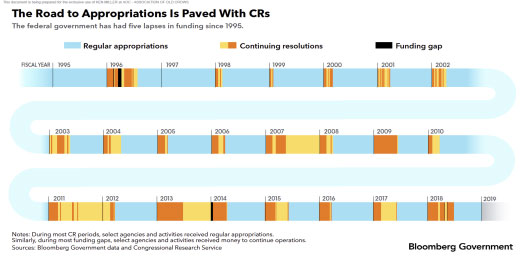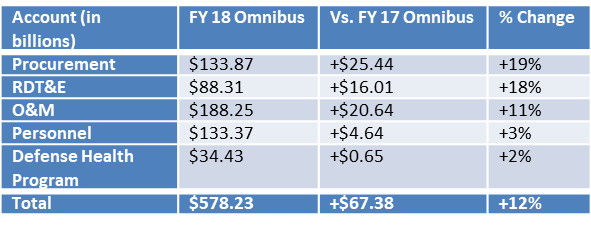AOC ADVOCACY UPDATE: Well, It’s Not May: Congress Completes Work on FY 18 Budget
Print this Article | Send to Colleague
By Ken Miller, AOC Director of Advocacy and Outreach
Last week, Congress passed a massive $1.3 trillion FY 18 omnibus spending package that funds all-of-government for the remainder of the fiscal year. The government had been operating under a series of Continuing Resolutions (CRs), of which the latest was set to expire on March 23. The deal arrives nearly six months into the fiscal year, which is at least two months earlier than Congress completed the FY 17 budget last year (May 5, 2017). Still as the chart below from Bloomberg Government shows, government funding under CRs is becoming the norm and injecting uncertainty into the budget process at regular intervals throughout the year.

The bill also includes several authorizations and other policy provisions to attract support and accomplish certain legislative priorities before the 2018 congressional election season heats up. The spending measure reflects the recent agreement to adjust Budget Control Act (BCA) caps, providing an additional $80 billion in defense and $65.2 billion for Overseas Contingency Operations (OCO) funding that doesn’t count against the caps. The base funding in the bill provides $589.5 billion for defense, which does not include $70 billion previously approved by Congress for a total of $659.5 billion.
Defense Budget Overview
Below is a break-down of defense spending by category. In total, the Defense Department (DoD) receives an additional $67 billion for major spending categories, the largest increases of which go to procurement and RDT&E. Click here for the House Appropriations Committee summary of the major investments in the defense spending.
Table 1: FY 18 Defense Budget by Major Category

In addition to the defense budget, the omnibus bill also includes several authorizations, including the FCC reauthorization that passed the House in early March. The FCC bill, also known as the Ray Baum’s Act, includes key provisions from S. 19, the MOBILE NOW Act, which was discussed in greater detail in last week’s E-Crow and the AOC Advocacy Newsletter. While the MOBILE NOW Act has changed dramatically for the better, it still represents merely a tenable solution. It is far from perfect and keeps us on a path that advances a commercial broadband agenda that fails to adequately consider or understand military and national security activities in the EMS.
Outlook
A major disadvantage of waiting six months into the current fiscal year to pass a budget is that Congress has little time before it jumps into consideration of the next year’s budget. When Congress returns from its District Work Period in two weeks, attention will turn immediately to the FY 19 National Defense Authorization Act (NDAA) which is slated for committee mark-ups in the House and Senate beginning late April through May. FY 19 appropriations will have a much harder path. With only about 16 weeks of legislative business left between now and the congressional elections in November, it is widely expected that the next fiscal year will begin with a CR until early December, pending the results of the elections.
If you have any questions or need additional information about the FY 18 or FY 19 defense budgets, please do not hesitate to contact the AOC Advocacy Department. You can also join the AOC Advocacy Community Group through www.crows.org to receive the most up-to-date information.

